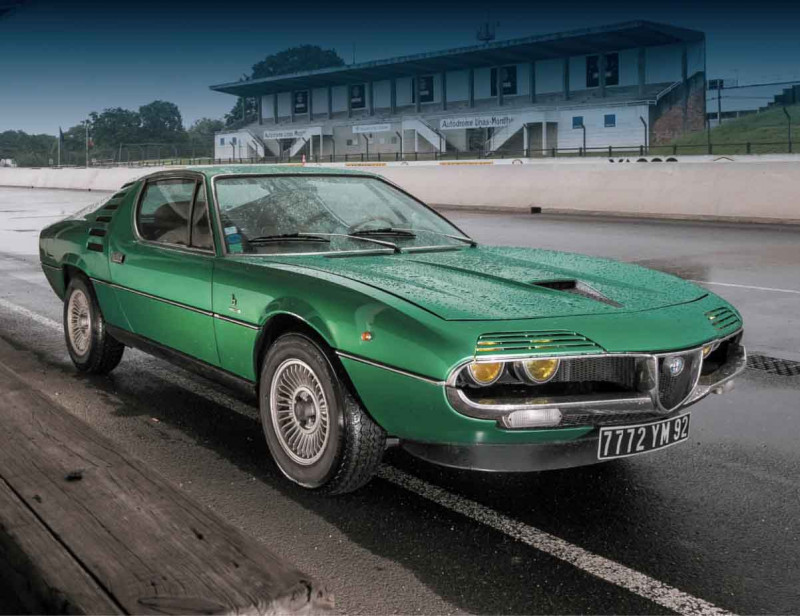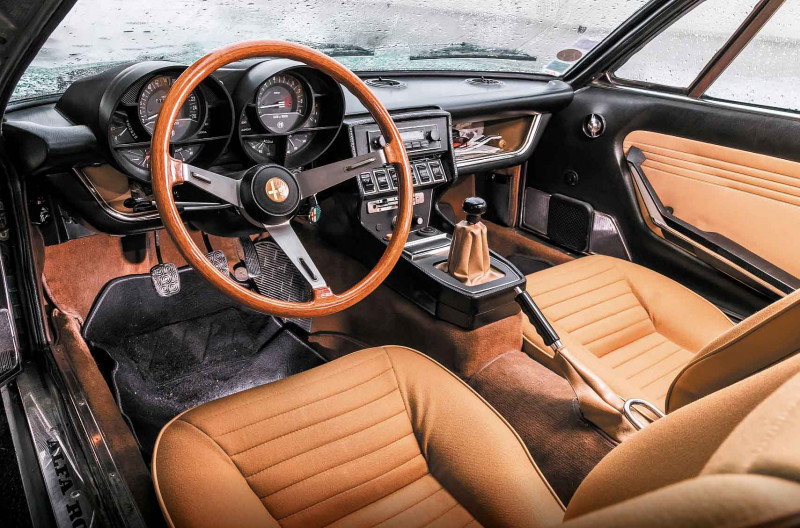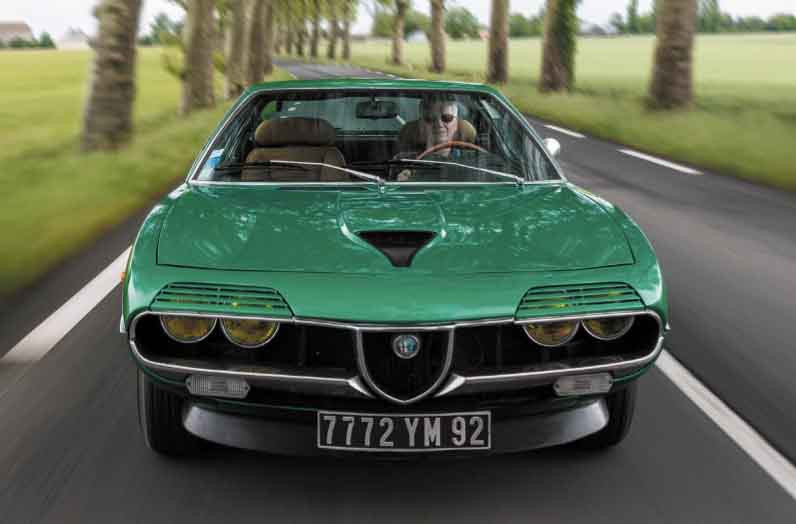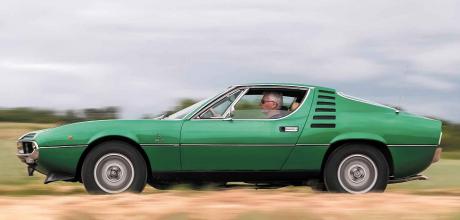1971 Alfa Romeo Montreal
Sublime and bizarre, enticing and unsettling, Montreal captivates the eyes, evoking admiration as well as criticism, residing somewhere between a paradoxical masterpiece and a missed opportunity. In this creation, nothing is ordinary, neither the appearance, nor the birth, nor the character.
By Robert Puyal
Photos: Nicolas Soler
Maximum power: 200 hp DIN
Maximum speed: 224.5 km/h
Price: €65,000
Production: 3,925 units (1971-1974)
A Particular View — Prestige. Alfa Romeo Montreal
We'll talk about the Montreal, but let's start with a digression. In 1970, when it made its appearance, Alfa Romeo was already an old brand, with its first forty years dedicated to luxury and high-performance vehicles. To put things in perspective, Fiat produced hundreds of thousands of cars, while Alfa Romeo focused on hundreds, in terms of both quantity and general excellence. Before the war, Alfa had taken thirty-four years to produce a maximum of 15,000 cars, which was the monthly production at Fiat, its Turin neighbor.

After the war and the almost complete destruction of the country, the Italian state introduced a very different set of priorities. Alfa Romeo, closely controlled like other manufacturers, was limited to a much more pragmatic production program. Nevertheless, the sporting spirit had not only survived but resurged. On the track, Alfa Romeo had significant successes, including the triumph of the 158 Alfetta, which secured the first two Formula 1 titles for Nino Farina and Juan Manuel Fangio. Other sporting adventures were less dominant, but Alfa Romeo still developed sporty versions from all the «normal» cars that their overseers wanted them to build. The 1900, a seemingly reasonable car, achieved success, both in its standard form and when supported by car body specialists like Touring and Zagato. Even as production expanded, the range extended downwards to include simple 1300s, which were still sporty alternatives to Fiat's and Lancia's cars. The Italian peninsula was filled with small sporty cars. The Giulietta and Giulia won trophies on Sundays, and in their sophisticated forms (the TZ1 and TZ2), they also excelled in FIA GT World Championship races.

But one area was missing from this ideal picture, an area where Alfa had excelled thirty years earlier: Grand Touring on the road. Ferrari, the dissident raised within Alfa, and Maserati, the elegant rival from Modena, now dominated this segment. However, ambitious independent manufacturers, newcomers to the automotive industry, also competed for the GT market, including Lamborghini, De Tomaso, Renzo Rivolta (Iso), Giotto Bizzarrini, and Frank Reisner (Intermeccanica), the friendly Canadian based in Turin. The primary idea behind the Montreal was to assert Alfa's dominance in this competitive arena.
For the historical context
The V8 engine would be taken from the race car, and the design was entrusted to Bertone, which had a young, how should I put it, Marcello Gandini. It was an enticing project, but things didn't go as planned. The board of directors was preoccupied with the successful opening of their second industrial front in Naples with the remarkable Alfasud. Consequently, the flagship project was somewhat sidelined, delayed, and compromised. It's highly likely that the project would have been abandoned if the car's design hadn't so strongly stirred the passions of the decision-makers. But it's worth noting that instead of a specific chassis, they used the somewhat narrow platform of the Giulia, which was not well-balanced with the larger engine, even though it wasn't very heavy. At the rear, a solid axle replaced the costly De Dion axle originally planned. The hoped-for stroke of genius didn't materialize, and Alfa didn't regain the upper hand, the prestige it had aspired to, or immediately challenge Enzo Ferrari. Fifty-two years later, the past technical delays and advances seem somewhat irrelevant, and there are still many delights to be found in this car, such as its design, V8 engine, and its distinguished emblem, which remains in this world even though it is under Fiat's control. Ultimately, these relative setbacks are minor, especially when compared to how other prestigious brands have been mistreated by fate.

For the visual and driving experience
We can view car brands as stable dynasties and follow the evolution of their models' styles. But to appreciate a designer as significant as Gandini, you need to be able to shift from one period to another. His first sketches were done at Bertone, one of Italy's most important car body manufacturers, from 1965 to 1980. Afterward, working independently, he created a series of diverse vehicles, whether expensive or affordable, united by his distinctive style. The Montreal was one of his creations. And now, we're finally on board. However, we're not done admiring its design. Alfa Romeo spared no effort on the decor, and the dashboard is unique: the two large traditional dials, the speedometer, and the tachometer, are each enclosed within rings of small indicators, forming two non-concentric circles. It's easier to understand by looking at the photos, but in any case, appreciate the attention to detail. The strongly curved steering wheel and the high beltline add to the exotic feel. This is no ordinary vehicle, and there are exciting things about to happen. It seems that the project engineers were somewhat undecided when it came to defining the target audience. A modern V8 engine with a relatively small displacement could have directly challenged Porsche and other contenders that were approaching the 200-horsepower range. And having a V8 engine could have been an opportunity to attract the American market. As a result, the chassis was torn between two conflicting goals, leading to a somewhat conflicted character. If the idea was to cruise at low speeds and let onlookers admire the car's style as you drove along Santa Monica, the soft suspension with ample travel, allowing you to even jump a curb at moderate speeds, was perfect. But what about the heavy steering and firm gearbox? And this sporty driving position? On the other hand, if the goal was to let the V8 unleash its power, which meant high RPMs, the race-ready gearbox with firm shifts and early engagement was perfect. But why not firm up the suspension a bit and reduce the steering's responsiveness? In short, if you've decided to share an intimate moment with the Montreal (because, let me tell you right away, we fell in love with its silhouette at first sight, and it didn't take more than a wink to win us over), you won't exactly know how to interpret its character. In all respects, the beautiful Montreal has objective flaws. It's neither accommodating nor particularly playful; it's a bit of an enigma, and so is its driver.

In the old-fashioned way
Let's be honest, it's entirely possible to overlook the complex personality of this car. Especially if, when introduced to it briefly, you don't dare to explore its engine thoroughly. However, if you do dare to rev it up towards the redline, the enthusiast in you gets as excited as the four carburetors, and from that moment on, there's no hesitation: you grip the steering wheel firmly, old-school style, control the oscillations with authoritative support, work the pedals relentlessly to leverage the precision of the ZF gearbox, in short, you put the whole car at the service of its engine. The following quarter of an hour takes us far away, equidistant from today's overengineered and high-performance sports cars and modern sedans that employ all their expertise to make you forget the road. The road becomes the responsibility of Miss Montreal; it's not all easy, but after all, where would the pleasure be? It's a truly old-fashioned sensation, and isn't that the primary appeal of a classic car?
A real designer's car, from the design of the headlights to that of the bumpers; nothing was allowed to spoil the perfect silhouette.
Serge, the owner
I purchased my Montreal in late 1986. It's my first Alfa. Since 2011, there's an annual Montreal gathering that I participate in. I love the low driving position, which reminds me of karting, and the captivating sound of the V8 engine, which despises traffic because it's tuned to run. It's a physically demanding car: no power steering, brake and clutch pedals that require strong force… And you have to be assertive when shifting gears!
The rear seats are almost unusable: no legroom, no headroom, no windows, and no light-colored leather like in the front.
For obscure aerodynamic reasons, the headlights are partially concealed under removable slats. It's impossible to determine their effectiveness, but it's undeniably beautiful.
More than the quality of the finish, which is a bit lacking, the interior owes its pleasant atmosphere to the design, the sound of the V8, and the excellent seats. The essentials are on the right: tachometer, oil pressure, water, and oil temperature. With the first gear downshift and firm shifts, the gearbox behaves like one dedicated to sport, and only sport.
TECHNICAL DETAILS 1971 Alfa Romeo Montreal
- Engine: V8, 16 valves
- Displacement: 2,593 cm³
- Tax horsepower: 13 HP
- Max Power: 200 hp SAE at 6,500 rpm
- Max Torque: 23 mkg at 4,750 rpm
- Fuel injection: Spica
- Transmission: Rear-wheel drive, 5-speed manual gearbox
- Brakes: Front ventilated discs / Rear ventilated discs
- Tires: Front & Rear 190/70 R 14
- Dimensions: Length x Width x Height 4.22 x 1.67 x 1.20 m
- Weight: 1,270 kg
- Top speed: 224.5 km/h
- 0-1,000 meters acceleration: 28.5 s
- Average consumption: 14 l/100 km
- Fuel tank: 63 liters
- Trunk capacity: Not specified
Thanks to the dry sump, the V8 engine sits very low. Born for racing, it deserved to power more Alfa models. The Montreal's spacious trunk matches its wanderlust spirit: a comfortable suspension and an engine that cruises effortlessly at 200...
Primarily a grand tourer, the Montreal is more at home in open spaces than on winding backroads. It can still take on the challenge, but at the cost of a fierce battle with its controls. A trendy creature, the Montreal often sported flashy colors: metallic green, gold, and a striking orange. But also classic white and red.


